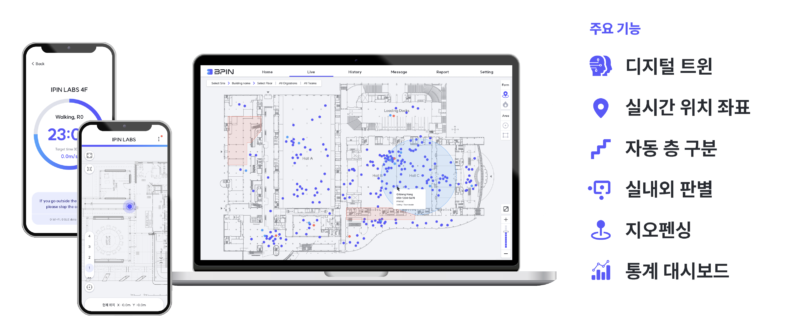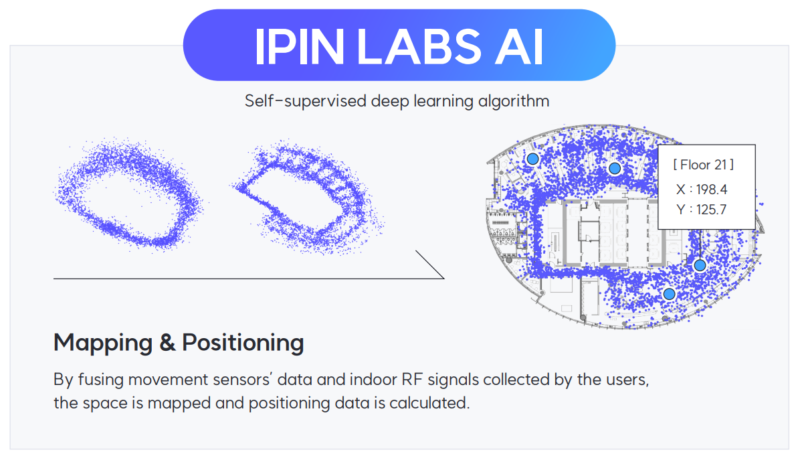Typically, individuals determine their location and movement paths using GPS systems, with car navigation being a prime example of GPS technology. But what about indoor spaces where GPS signals cannot penetrate? Without a special method, users are limited to referencing indoor maps or asking nearby people for directions. Today’s featured company, IPIN LABS, provides a solution called ‘BPIN’ that can track people and objects in indoor spaces where GPS is unavailable.

Indoor positioning technology has diverse applications, but it is particularly valuable for companies and institutions that need to continuously monitor critical assets. For instance, hospitals operate numerous medical devices, and pinpointing their real-time locations is challenging. Similar challenges exist in high-tech industries like semiconductor manufacturing, where smart factories have numerous high-value assets spread across large spaces.
Historically, companies managing critical assets found real-time location tracking extremely difficult. Typically, they relied on manual records from the last user to determine an asset’s location. However, as the number of managed assets grows and urgent usage becomes more common, precise location tracking becomes crucial. Recognizing this need, IPIN LABS developed a system that tracks critical asset locations in real-time, even without GPS.
The method employed by IPIN LABS is the SLAM (Simultaneous Localization And Mapping) technique. SLAM enables real-time location and map generation as a user or object moves through a space. This technique, also applied to autonomous robots requiring precise indoor navigation where GPS is ineffective, is a complex technology that simultaneously generates location data and mapping information.
Importantly, IPIN LABS implements SLAM by leveraging existing communication infrastructures like WiFi, Bluetooth, and LTE across various RF (Radio Frequency) environments, without requiring new or specialized devices. This approach eliminates the need for special additional costs or environmental modifications for indoor positioning technology implementation.
IPIN LABS’ competitive advantages become evident when examining competitor technologies
The primary indoor positioning technology is ‘beacon’ tracking. Beacon methods require ‘anchors’, typically using low-power Bluetooth (BLE) or ultra-wideband frequency (UWB) installed throughout indoor spaces. While beacon methods offer relatively low error rates, they necessitate costly hardware and communication environment reconstructions.
Moreover, space changes require manufacturers to reinstall anchors, incurring significant maintenance expenses. An alternative method, ‘fingerprinting’, uses existing communication environments without anchors, making it cheaper. However, its error margin exceeds 10 meters, rendering it impractical for indoor use.
IPIN LABS’ BPIN solution stands out by reducing costs through existing communication infrastructure while achieving accuracy comparable to or exceeding beacon-based systems.

The process is remarkably straightforward: creating an indoor map requires only two or three smartphone-guided traversals of the space. During movement, the system calculates trajectories using smartphone sensor data, refines them with indoor infrastructure data, and then employs an AI model to classify and improve trajectory accuracy. The resulting map enables indoor navigation, and by attaching tags to critical assets, customers can monitor their real-time locations.
The field performance results are promising. IPIN LABS conducted Proof of Concepts (PoC) across various sectors, including manufacturing, construction, healthcare, and transportation. Consistently, they outperformed competitors in implementation costs, accuracy, and time efficiency. One large corporate subsidiary that tested the product is already expanding its implementation across group subsidiaries.
The indoor positioning technology market outlook appears favorable. Before IPIN LABS’ solution, beacon technology dominated with few alternatives, despite high costs. Some beacon companies even achieved NASDAQ listings.
Offering advantages like lower costs, minimal maintenance requirements, and adaptive communication environment response, IPIN LABS is currently conducting global PoCs with companies in Taiwan, France, and Japan, with promising results anticipated soon.
Founded by Jae-hyun Yoo and Seon-hyeok Kang, doctoral researchers from Seoul National University’s Autonomous Robotics Laboratory, IPIN LABS has transformed their academic expertise into a promising technological solution.
Their technological prowess was recently recognized when they were selected in the top three and received the excellence award at the ‘CJ GLO!VentUs(Global+Venture+Us) 2nd Batch Top 10 Demo Day’. The program, a global open innovation initiative by CJ and Gyeonggi Creative Economy InnovationCenter, supports domestic startups with global market potential.
It remains to be seen whether IPIN LABS will successfully ‘pin’ itself at the top of the indoor positioning technology market.

What problem is the IPIN LABS team trying to solve?
Navigation technologies typically rely on GPS for location tracking. However, determining the precise location of people or objects in GPS-inaccessible indoor spaces presents a significant technological challenge. IPIN LABS is developing technology that can track locations in such environments. While indoor location tracking has been extensively researched, technological barriers have constrained market expansion. By leveraging AI technology, IPIN LABS is breaking through these barriers to create an indoor location tracking solution that is both accessible and efficient.
How does IPIN LABS solve this problem?
The company has implemented AI technology to overcome critical technical obstacles. This approach offers a solution that requires no additional hardware installation, can be deployed within a day, and operates without necessitating manufacturer site visits.
What are our competitive advantages compared to competitors?
Competing technologies demand additional hardware for indoor communication, resulting in prohibitively high implementation costs and extensive deployment time. They typically require complex electrical and communication infrastructure modifications, making technology expansion challenging. In contrast, IPIN LABS’ technology utilizes existing communication infrastructure, offering key advantages including rapid deployment, simplified maintenance, and significantly lower initial implementation costs.

What product/service do we provide? What is its current status?
IPIN LABS provides customers with a two-dimensional digital twin asset management solution. The system enables real-time monitoring of asset locations within indoor spaces, directly contributing to improved productivity and safety for adopting enterprises.
What is our target market size and core target customers?
The current global landscape shows tremendous interest in digital transformation. IPIN LABS bridges the gap by digitizing asset location management previously handled manually. Their solutions target large indoor environments such as smart factories, logistics warehouses, airports, and hospitals, accelerating digital transformation across industries. The company is continuously advancing its technology to adapt to evolving communication markets, with plans for expansion into 5G signal-based technologies.
What is our business model?
The company offers two primary business model formats: API and complete SaaS. The API format caters to large enterprises requiring integration with existing legacy systems, while a subscription-based SaaS serves clients without complex system integration needs. Additionally, IPIN LABS provides flexibility through both cloud and on-premises service options, particularly appealing to organizations with stringent security requirements.
What have been the team’s achievements so far?
Since its founding in 2022, the company has secured seed investments from prominent institutions like Gyeonggi Creative Economy Innovation Center, Bluepoint Partners and Future Play. They’ve been selected for TIPS R&D and early startup programs. Domestically, they’re collaborating with industry leaders including SK Telecom, Hanhwa Vision, Hyundai Construction, Seoul National University Hospital, and T-money. Internationally, they’re developing partnerships with companies like SNCF, Wistron, and NEC.
What is the team’s competitive advantage?
Led by CEO Jae-hyun Yoo, a PhD from Seoul National University specializing in AI-based indoor location tracking, the team comprises seven highly specialized professionals. They distinguish themselves through world-class technology development and commercialization capabilities. Their shared competitive advantage lies in a collective spirit of confident innovation and eagerness to embrace new challenges.
What efforts and achievements do you have for overseas expansion?

The company has pursued international growth through strategic approaches: participating in professional exhibitions, engaging in government-supported global projects, joining overseas accelerator programs, and implementing proactive sales strategies. Notable achievements include two consecutive CES participation years (2024-2025) and winning the 2025 CES Innovation Award. They’ve also attended VIVA Tech and Japan IT Week, establishing multiple overseas Proof of Concept (PoC) cases. Their selection for Wistron’s acceleration program led to a collaborative indoor location tracking solution development.
How is the ‘CJ GLO!VentUs’ program helping with overseas expansion?
The program facilitated crucial meetings with international manufacturing companies seeking indoor location tracking technologies. The comprehensive feedback received will be instrumental in refining IPIN LABS’ technological solutions and market approach.
Three reasons why we need investment
First, we need to secure indoor location tracking technology comparable to GPS value and secure the global market.
Second, investment is necessary to confirm market potential through technical verification with numerous domestic and international large enterprises.
Third, we request investment from investors to respond to market changes through 5G technology expansion.
MORE FROM THE POST
- [Korean Startup Interview] From Text to CAD: How Herewe’s EaseAI Is Revolutionizing Product Design
- [Korean Startup Interview] Dtonic, “Tonic Data to Recreate High Value… Targeting Over $25 Million in Revenue This Year”
- [Korean Startup Interview] HYUNSUNG, “Revolutionizing Global Logistics with Smart Labels and AI-Powered Platforms”
- [Korean Startup Interview] BeringLab: “Expanding Globally with Specialized AI Translation for Law, Patents, and Clinical Fields”
- [Korean Startup Interview] Deepvisions: Revolutionizing Air Pollution Monitoring with AI-Powered Vision Technology
- AI
- BPIN
- CJ
- CJ Glo!VentUs
- CJ group
- EN
- Gyeonggi CCEI
- Interview
- IPIN LABS
- Korea
- Korean startup
- SLAM
- Startup Together
- wow together
- WOWTALK
Share
Most Read
- 1
- 2
- 3
- 4
- 5



Leave a Reply